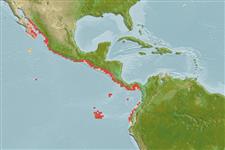Environment: milieu / climate zone / depth range / distribution range
Ekologi
marina; djupintervall ? - 70 m (Ref. 96339), usually ? - 50 m (Ref. 11035). Tropical; 28°N - 3°S, 112°W - 78°W (Ref. 54686)
Eastern Pacific: Santa Rosalita, Pacific coast of Baja, California, Mexico southward to Punta Sal and Punta Picos, Peru. (Earlier works probably combined data for Opisthonema bulleri and Opisthonema medirastre). Range is extended northwards to San Pedro, California (Ref. 35601). Rare on outer coast of Baja California Sur (Ref. 35601).
Size / Vikt / Age
Maturity: Lm ? range ? - ? cm
Max length : 30.0 cm TL hane/ej könsbestämd; (Ref. 55763); common length : 22.0 cm SL hane/ej könsbestämd; (Ref. 9291); publicerad maxvikt: 261.36 g (Ref. 124487)
Short description
Bestämningsnycklar | Morfologi | Morfometri
Taggstrålar i ryggfenan (totalt) : 0; Mjukstrålar i ryggfenan (totalt) : 13 - 21; Taggstrålar i analfenan: 0; Mjukstrålar i analfenan: 12 - 23. The filamentous last dorsal fin ray distinguishes it from members of any other eastern Pacific clupeoid genus. Separated from eastern Pacific Opisthonema species by having 63 to 110 lower gill rakers in fishes over 14 cm standard length.
Usually occur near the surface of coastal and offshore waters, down to over bottom of continental shelf (Ref. 11035). Form dense schools. Apparently the most abundant of the eastern Pacific species of Opisthonema. Feed on phytoplankton (dinoflagellates and diatoms). Oviparous, with planktonic eggs and larvae (Ref. 35601). It is reduced to fish meal (Ref. 9291). Oil may be extracted (Ref. 9291). May be canned (Ref. 9291).
Whitehead, P.J.P., 1985. FAO Species Catalogue. Vol. 7. Clupeoid fishes of the world (suborder Clupeoidei). An annotated and illustrated catalogue of the herrings, sardines, pilchards, sprats, shads, anchovies and wolf-herrings. FAO Fish. Synop. 125(7/1):1-303. Rome: FAO. (Ref. 188)
IUCN Red List Status (Ref. 130435: Version 2024-1)
Threat to humans
Harmless
Human uses
Fiskeri: kommersiellt viktig; bete: occasionally
Verktyg
Special reports
Download XML
Internet-källor
Estimates based on models
Preferred temperature (Ref.
123201): 21.4 - 29, mean 27 °C (based on 86 cells).
Phylogenetic diversity index (Ref.
82804): PD
50 = 0.5312 [Uniqueness, from 0.5 = low to 2.0 = high].
Bayesian length-weight: a=0.00676 (0.00395 - 0.01157), b=3.06 (2.91 - 3.21), in cm total length, based on LWR estimates for this species & (Sub)family-body (Ref.
93245).
Trofisk nivå (Ref.
69278): 2.9 ±0.28 se; based on food items.
Resiliens (Ref.
120179): Hög, lägsta populationsfördubblingstid mindre än 15 månader (K=0.22-0.5).
Prior r = 0.43, 95% CL = 0.28 - 0.64, Based on 2 full stock assessments.
Fishing Vulnerability (Ref.
59153): Low vulnerability (25 of 100).
Climate Vulnerability (Ref.
125649): Moderate vulnerability (37 of 100).
Nutrients (Ref.
124155): Calcium = 199 [90, 362] mg/100g; Iron = 1.94 [1.10, 3.34] mg/100g; Protein = 18.6 [17.5, 19.7] %; Omega3 = 0.37 [0.21, 0.67] g/100g; Selenium = 48.5 [23.7, 99.5] μg/100g; VitaminA = 26.8 [9.3, 78.7] μg/100g; Zinc = 1.41 [0.97, 2.09] mg/100g (wet weight);
